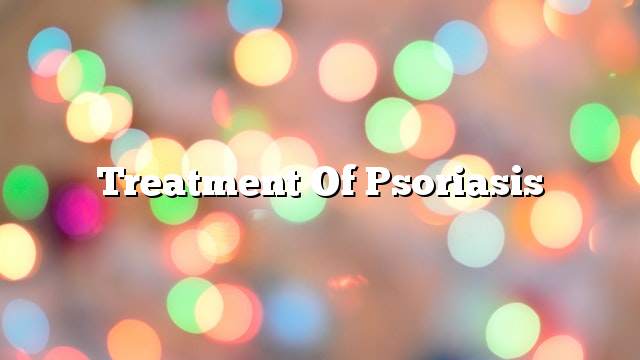The treatment is divided into two parts of medicine, radiation therapy and alternative medicine
1 – Drug therapy and radiation: There are many medicines used in this field, including:
• Use vitamin D-like creams such as calcipotriol (Calcipotriol) and is used in cases where the skin is under 40% and does not cause an increase in calcium in the blood if used in the dose approved. It is odorless, colorless and does not stain the skin, it helps in reducing the crusts. It should not be used on the face
• Using vitamin A-derived creams such as tazarotin cream, which reduces the increased proliferation of keratinocytes. It is used in regular cases of psoriasis, which covers less than 20% of the body and is used once at sleep. The important side effect is irritability and allergies, and should not be used during pregnancy and lactation.
• Cortisone topical cream: Doctors consider it the primary treatment option for stable psoriasis. It relieves crusts and reduces redness, such as betamethasone.
However, its use is the rapid return of the disease after completion of treatment, and skin atrophy in the case of long use of it, and the use of large doses on large areas of the body lead to side effects similar to oral steroid.
• Use Tar As a treatment for psoriasis, especially areas where hair is located, and uses tar as shampoo, creams or lotions. It is most effective when combined with the use of topical cortisone in a sequential manner.
• Salicylic acid: It is usually used at a concentration of 2%, but skin specialists are also described as 3-6%. It reduces cortex and has anti-inflammatory effect, and also helps in getting other topical medications to the areas of infection.
• Calcinorine inhibitors: Examples include tacrolims, a drug used to treat psoriasis in the face and genital areas.
• Exposure to sunlight and ultraviolet radiation: The beam with narrow, wide beams uses ultraviolet radiation B and uses narrow-wave radiation along the 311 wavelength which is effective for treating psoriasis and to avoid cancer-causing wavelengths.
The main risk of short treatment is the toxicity of radiation and allergies. In the case of long treatment, the main problems are the damage to the skin as well as skin cancer.
Oral Surfactants with Ultraviolet (A) UVA (PUVA): Suralin is taken as oral tablets and after 2 hours the patient should be exposed to radiation A with PUVA, and exposure to the radiation is required 2-3 times a week.
Side effects are painful redness, itching after and during exposure to radiation, nausea caused by suralin, and long-term skin aging and skin cancer.
• Acetretin pills (vitamin A blockers): It reduces the size of the spots, and the side effects dry mouth, lips, eyes, skin scaling, itching, nail inflammation, hair weakness and fall.
And the effect on the functions of the liver and high lipids and therefore should be monitored for these functions throughout the treatment period, and is considered the fetal deformity is the most important side effect, so it is not used by pregnant women, and the continued presence in the blood due to compounds that result from the analysis, which is also distorted fetus led To use the pill for two years after stopping treatment.
• Use of methotrexate: It inhibits the action of lymphocytes, which is initially given once a week as milk, and then gradually increases the dose. Side effects of the drug are congenital deformity of the fetus, nausea, hallucinations, high liver and kidney function, as well as inhibition of bone marrow function. Folic acid is taken with the drug to reduce drug toxicity.
• Use of cyclosporine: It is used for short periods to prevent the side effects of prolonged exposure to the drug, most importantly high blood pressure and the effect on kidney function, and treatment should not last more than a year in case of uncontrolled side effects.
• Use of biological agents: Examples include etanerasep, enfleximab and others. The choice of medication depends on the type of psoriasis and the cost of material and how to give medicine and effectiveness and associated diseases (arthritis).
• Combination of these treatments, including vitamin D flakes with topical steroid or ultraviolet radiation.
Psoriasis is a chronic, non-contagious skin inflammation that appears in the form of red spots with silver scales. The most affected areas are the skin of the knees, elbows, the scalp and the lower back area.
2 – The disease spreads in light-skinned people in Europe and North America, the incidence rate is 1-3%, and spread in people aged 15-40.
3. Parents with psoriasis are more likely to transmit the disease to their children than infected mothers
4 – In addition to the genetic factor, there are some factors that stimulate the emergence of psoriasis, including infections and hormones and some medicines and infections (sore throat and AIDS).
5- Psoriasis is divided according to the shape and location of the injury to eight types, namely psoriasis, psoriasis, nail psoriasis, folds, psoriasis, palm rest, psoriasis, psoriasis, psoriasis and redness.
6. The diagnosis of the disease depends on the clinical examination, where the presence of red spots with silver crusts in the spread of the disease.
7. Complications of psoriatic arthritis, secondary infection, increased risk of lymphoma, and increased cerebrovascular disease.
8. Treatment with drugs and radiotherapy includes the use of topical treatment with creams such as cortisone, vitamin D derivatives, A, tar, salicylic acid, radiation therapy such as sun, UVB, oral therapy or injections such as suralin (with UV A), acetretin and methotrexate Cyclosporine and biological materials.
9 – Herbal treatment includes cactus, acetate, red pepper, licorice, fenugreek, walnuts, Brazil, chamomile, the king and other herbs.
1. fitzpatrick’s color atlas and synopsis of clinical dermatology 6th edition
2. Dermatology, Fourth Edition By Richard P.J.B. Weller, John A.A. Hunter, John A. Savin and Mark V. Dahl
3-: //emedicine.medscape.com/
4-herbalremediesworld.com/home-remedies-psoriasis.html
